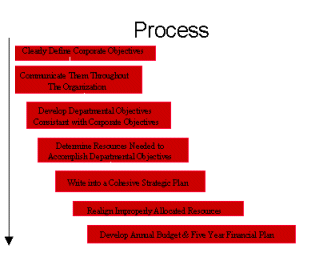|
Why do Venture Capital Firms put so much emphasis on evaluating execution risk prior to making and investment in a company? They know that businesses with much perfectly sound business plans fail, not because their plans didn't have merit, but due to lack of execution. A very high percentage of companies backed by Venture Capital Firms fail. Many, if not most, fail not because of a poorly thought out business plans, but because of poor execution. Many companies spend countless hours and endless meetings discussing and developing a strategic plan, and then fail to properly implement their plan.
How can the risk of execution be lowered? This article outlines a process that significantly lowers execution risks and describes common pitfalls companies encounter when trying to implement their plans. This process is quite similar to Hoshin Planning in that it aligns the whole organization toward the achievement of corporate objectives and measures performance against those objectives.
Premise
A company is most likely to succeed when it clearly define corporate objectives that are key to the company success, and then allocate all the company resources toward achieving those objectives. Sounds pretty simple, but a majority of businesses do a poor job of executing this process. Most companies either do not have well defined objectives or fail to properly allocate the resources necessary to achieve those objectives.
The process
The process is not difficult to understand, but it is difficult to implement. The first step in the process is to develop clear, well-defined corporate objectives that are critical to the success of the company. This should be done at the senior management level. These objectives should be concise general objectives, such as, improve cash flow, increase market share, add new products, etc. Assuming there is talented middle management in place, they should develop the plan on how to accomplish these objectives. If not the company is wasting some valuable resources.
The company should then communicate these objectives to the entire organization. This can be done through meetings with middle management, company wide meetings, departmental meetings, posting on the intranet, and through the company newsletter. Any and all means should be used to communicate these objectives to the company. When objectives have not been clearly communicated, problems in execution will exist.
Middle management should develop departmental objectives that tie to the corporate objectives. The senior management team should review all their direct reports' objectives to assure alignment with corporate objectives. This is where the CEO and senior management can provide guidance to the middle management on how they can contribute to the success of the company. By waiting until middle management comes up with their own plan, the company has accomplished two things. First, the middle management takes ownership in a plan they have developed, even if executive guidance is needed. Additionally, the creative talents of middle management have been used to develop a stronger plan than could have been developed by senior management alone.
The next step is to align departmental resources (budget) with departmental objectives. A company should make sure that all personnel and funds are being used to drive toward the accomplishment of departmental objectives. In this process improperly aligned resources are typically discovered. By redirecting these resources toward the accomplishment of departmental objectives, the company has not only saved money but also increased their chance of achieving their corporate objectives.
Then the company should develop a detailed budget and five-year financial plan that reflects the proper allocation of resources and the likely result of properly executing their strategic plan.
The next step is to document all the elements of the plan into a well-written document. It can be called a business plan or a strategic plan, but far more important than what it is called is how it is used. This should be used for both internal and external communication to employees, investors, lenders and business partners (there may be different versions which speak to different audiences). This is a company's road map on how it is going to achieve its objectives. It is not something that is done once every one or two or three years then filed away.
Everyone in the organization should be familiar with the plan and be able to correlate their daily activities to the achievement of it. If not, they should feel comfortable enough to ask, "Is what I am doing today helping achieve our corporate goals?" All the people in the company should be periodically performing an audit of their activities.
The final step is for an organization to measure its performance. This should be done on two levels. First, on a financial level, it should use the familiar actual vs. budget reporting. Then, the organization should use operational drivers to measure operational performance. An organization needs to identify key operational drivers that will move the departments toward the accomplishments of their objectives, and then find the appropriate way to collect the information and report it. Operational drivers will many times identify where the organization is not meeting its objectives much earlier then when it is revealed through financial reporting. This early detection will allow management to make adjustments to their plan.

Next
* Dennis Crumb is a CPA, MBA, teaches Corporate Finance at Regis University and provide consulting services for small to medium sized business focused on buisness planning and financial forcasting. To know more, visit the link www.crumbandassociates.com
|